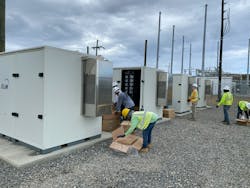Modernizing the Grid in Micro Steps: Factors Driving Utilities to Adopt Distributed Microgrid Battery Energy Storage Systems
With new technologies there are always multiple factors that drive adoption within the utility industry, and through ELM’s work with utilities across the country we have found three common drivers leading utilities to install smaller 1 MW to 5 MW microgrid capable BESS systems.
- Substation Resiliency and Non-Wires Alternatives
- Time of Use Cost Shifting
- Grid Modernization to handle EV Adoption
Substation resiliency and non-wires alternatives
There are over 55,000 substations in North America, ranging from very large transmission level to very small distribution level stations in remote rural locations. Traditionally, distribution substations provide resiliency by installing a secondary loop feed to the substation or by adding emergency fossil fuel generators to provide additional backup. Utilities are now finding value in utilizing BESS systems with full microgrid functionality to provide the resiliency required for these substations. Microgrid BESS systems can be more cost effective than running miles of secondary utility line and require less maintenance than fossil fuel generators while responding to outages in a fraction of the time. In some instances, our systems have been deployed by utilities as a complete non-wires alternative. This takes the customer completely off the main grid and provides their power from a local microgrid, increasing their uptime while reducing environmental risks of power line failures, such as wildfires.
Time of use cost shifting
A benefit of BESS microgrid systems is that while they are available for resiliency on a moment's notice, they also “like” to be utilized on a regular basis. One of the first things we share with customers is that the batteries in their BESS system will live a longer, healthier life if they are cycled on a regular basis. This means that BESS systems that have been installed for resiliency, with the proper energy management system (EMS), are able to provide the utility with monetary value daily by storing energy at times when energy costs are low and utilizing that stored energy at times when costs are high. This functionality enables the BESS to pay for itself several times over during its lifetime. Additionally, many smaller utilities and co-ops can generate a portion of their energy needs through local renewable generation sources, such as solar PV arrays. The BESS system is able to harvest that energy to be utilized at a time most valuable to the utility and their customers.
Grid modernization to handle EV adoption
Microgrid BESS adoption to address additional required spinning reserve to support EV charging is the fastest growing factor for utilities. While there is a significant focus on how to support public EV charging stations, the vast majority of EV charging is going to take place at home. Home EV chargers have the potential to more than double the peak demand that a utility sees from an average household. This is not a large number on a per home basis, however the impact is significant when applied to every house active on a distribution substation.
Obviously, doubling the size of every distribution substation would be quite challenging considering factors such as available physical space and transmission feed to support the expansion. Also challenging for the utility is that this demand is not constant but is actually periodic by nature, most likely resulting in peak requirement of four to five hours per night. The installation of a BESS system at the substation with an EMS system that can intelligently handle these additional load requirements is proving to be a cost effective and timely solution to this challenge.

